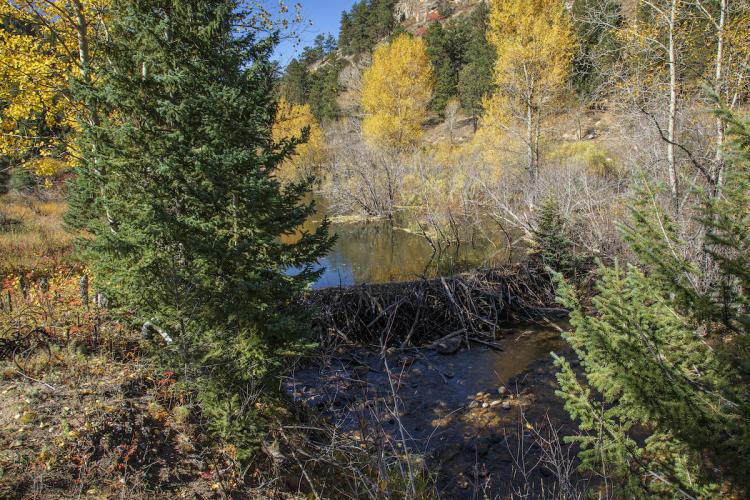Beavers have become established in Boulder Canyon
Beavers may appear to be one of the most sedentary of species, living in a secure den or lodge in a pond with all of their food within a short waddle, but now, in Boulder Canyon and in Alaska, it is evident that they are on the move
Beavers have become established in Boulder Canyon. Dave Hoerath, wildlife biologist with Boulder Parks and Open Space, told me that they have been aware of beavers in Boulder Canyon for about 10 years, but we agreed that the pond in the photos illustrating this article appeared recently.
At two sites, 1.5 miles apart, aspen, cottonwoods, and willows have been gnawed down to build dams and to cache branches for winter food.
A beaver pond is the territory occupied by one family of beavers. The parents are monogamous, and they mate for life—longevity has an average of 12 years but fortunate and healthy beavers can live 19 years.
Once the pond is formed, the adjacent soils become saturated, killing some species, but making the area ideal for alders, willows, aspens and cottonwoods—all favored foods of beavers. They may excavate a canal to a nearby grove of trees so they can easily transport branches and twigs to their pond.
They mate in January or February, and usually three or four kits are born in May or June. A family consists of the adults, the kits and yearlings born the previous year. Yearlings leave their natal ponds as they approach their second birthday and a new set of kits is imminent. They travel as far as five or six miles to establish their own territories.
Beavers are large rodents, second only to capybaras in South America. They grow to be a meter long, with one-third of that being their black, flat, naked and scaly tails. They are semiaquatic, with specific adaptations for living in the water. Toes on the back feet are webbed and they can close their nostrils and ears when submerged.
They have clear inner eyelids that they close underwater so they can see without getting sand or detritus in their eyes. They are able to control their breathing and heart rate to remain underwater for five minutes but when a predator is skulking about they can stay down for as long as fifteen minutes.

At the top of the page: Beavers have constructed two dams in Boulder Canyon—this one is about five feet tall. Above: Boulder Creek now flows into beaver ponds that appeared about a year ago; this one is the smaller of the two. Photos by Jeff Mitton.
To warn their family of imminent danger, they slap the water with their flat tails, producing a sharp retort that can be heard both above and below water. While they have a lumbering and ponderous gait on land, they are agile in the water.
Their primary predators are bobcats, coyotes and wolves. In Voyageurs National Park in northern Minnesota, a collared wolf ate 36 beavers in one year. Beavers are most vulnerable when searching for new territories or when collecting logs and branches.
Today, only two species of beavers survive, our North American beaver, Castor canadensis, and the very similar Eurasian beaver, C. fiber. Adults weigh 30 to 70 pounds. Giant species of beavers evolved in Europe and North American during the Pleistocene.
A beaver in North America in the genus Castoroides was as big as a black bear and weighed about 220 pounds. The giantbeaver did not gnaw wood or eat bark, but fed on submerged vegetation in swamps. It went extinct about 10,000 years ago, as North America was becoming more arid and swamps became smaller and less common.
Beavers are frequently presented as nature's engineers, for they change their environment substantially. They gnaw down aspen and cottonwoods more than a foot in diameter to build a dam. Their dam to creates a pond where they then build a den or lodge as a refuge from threatening predators and harsh weather. Dens are at the edge of the pond, while lodges are surrounded by water. Both have underwater entrances to exclude predators.
Once the pond is formed, the adjacent soils become saturated, killing some species, but making the area ideal for alders, willows, aspens and cottonwoods—all favored foods of beavers. They may excavate a canal to a nearby grove of trees so they can easily transport branches and twigs to their pond.
Trout seem to flourish in beaver ponds, and muskrats, mink and ducks drop in as well. Over the years, sediment flowing into the pond makes it shallower, eventually forcing the beavers to abandon the pond as it transitions to a meadow.
Aspen, cottonwood and willow branches not incorporated into the dam or den are cached either underwater or in a storage room inside the lodge so they can eat the bark in the winter. When the pond freezes over, they can safely retrieve branches from underwater caches.
Climate change has been implicated in the movement of the geographic ranges of many species of animals. Many species are expanding their ranges to higher elevations and latitudes in the northern hemisphere. Beavers might be added to this list, for they have moved farther north in the Arctic tundra of Alaska, creating more than 12,000 new ponds.
In 2020 the temperature in the Alaska tundra rose higher than ever in recorded history, coincident with the invasion of the tundra by woody shrubs. This provides the building materials for dams and lodges and food to sustain beavers through the winter.
Beavers may appear to be one of the most sedentary of species, living in a secure den or lodge in a pond with all of their food within a short waddle. But now, in Boulder Canyon and in Alaska, it is evident that they are on the move.

